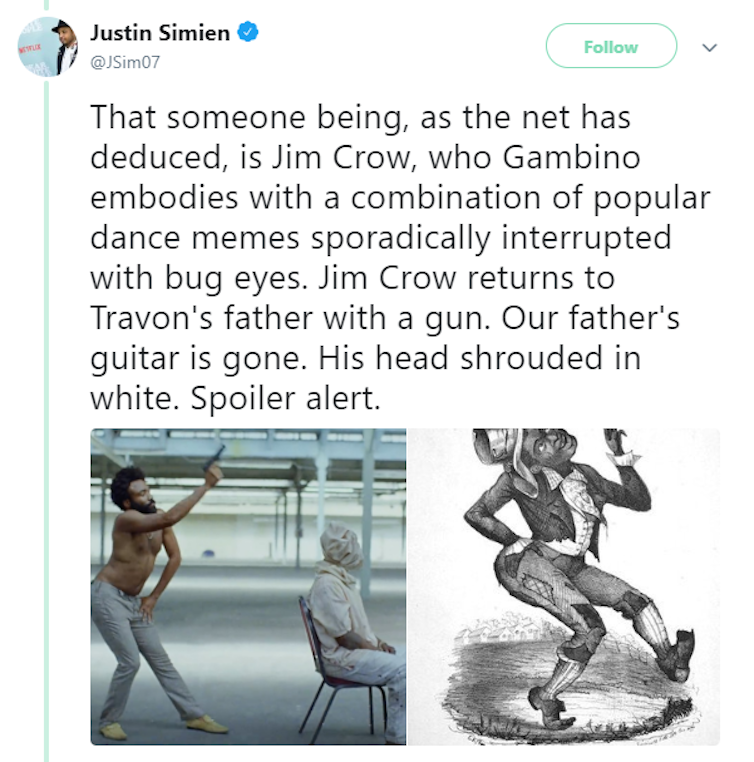Childish Gambino’s new music video for his song ‘This is America’ was viewed almost 50m times in five days. It is a remarkable artistic achievement given that it utilises finely-tuned choreography to satirise the role of the black man’s supposedly “joyous” song and dance routine.
The release of the video was particularly timely. Encountering the Hiro Murai-directed promo brought some much-needed satisfaction – and sanity – to a week that had notably featured a Trump-endorsing Kanye West claiming slavery was “a choice”.
After already amassing over 50 million YouTube views, This is America has demonstrated the potential for an artist like Donald Glover – aka Childish Gambino – to use popular culture to critically address ongoing and deeply-ingrained issues surrounding race.
Not so ‘happy’ after all
It achieves this while simultaneously criticising popular culture for placating audiences. It can be seen as the antithesis of Pharrell Williams’s ‘Happy’ – a video that achieved its own constant rotation via more obvious feelgood escapism.
Glover’s hard-hitting cynicism can be pitched against Williams’ most buoyant song in a way that recounts Public Enemy’s 1990 citing of Bobby McFerrin’s similarly rose-tinted ‘Don’t Worry Be Happy’ as little more than a distraction within their own call-to-arms, ‘Fight the Power’.
Perhaps most controversial of all, This is America appears to openly question the entertainment industry’s support for what amounts to a continuation of “minstrelsy” (the once highly popular 19th-century “blackface” tradition that relied on damaging racist stereotypes). This aspect was picked up by creator of the comedy Dear White People, Justin Simien, who observed how Glover even contorts his body into the caricatured figure of Jim Crow – a slave archetype who was a mainstay of such performances.

Utilising sharp choreography as part of his own bewitching performance, he leaves no misunderstanding about where he locates either the origins or the current role of the black man’s upbeat song and dance routine.
As a video, it immediately appears to have some kinship with Beyoncé’s Grammy-nominated ‘Formation’. Both appear to pull us towards the motivation behind the Black Lives Matter campaign but, more than that, these are both examples of the music video as a politicised event. Formation is a fierce commentary on events from Ferguson to Sandra Bland to Eric Garner and Freddie Gray. The video marked Beyonce’s entrance into the political sphere while also ensuring that it is couched in mass appeal.
As cultural theorist Sunil Manghani identified, these videos transcend the format of the music video itself, resulting in “a combined ‘object’ of music-video-news as it forms and reformulates through social media, news networks, and print journalism”.
Glover has now had a “moment” where he has dominated a cultural conversation by presenting work that is so fully formed in its complexity and accessibility.
A satirical dance
What is so remarkable about the way in which Glover used the form of the music video as a politicised event is in the layered and nuanced content with a direct message. Peppered throughout the video are the traces of various dance styles, from viral video moves to Blocboy JB’s shoot dance, to the South African Gwara Gwara. Brought together, the differing origins form something that looks very American and which Glover appears to comment on directly.
Placing the choreography so front and centre seems to be saying that that mainstream culture is all America sees when they see the black community. The exaggerated facial expressions while dancing in the video, further pointing to the disparaging caricatures of the black man popularised in the Jim Crow era.
The Sunken Place
At the end of the video, Glover is seen running in semi darkness being chased by a group of what seem to be non-black people. Like many on Twitter have theorised, it is plausible to suggest that Glover is in fact running from the Sunken Place – a concept developed in Jordan Peele’s film Get Out.
The Sunken Place represents a system that no matter how hard individuals and groups protest, it will silence them. As Peele explained:
You know when you’re going to sleep and it feels like you’re about to fall, so you wake up? What if you never woke up? Where would you fall? And that was kind of the most harrowing idea to me. And as I’m writing it becomes clear that the sunken place is this metaphor for the system that is suppressing the freedom of black people, of many outsiders, many minorities.
![]() Glover in effect represents this concept through choreography and visual imagery in just four minutes and four seconds. Like Beyoncé, Glover has offered up a multi-layered political statement and one which the mainstream is now grappling with. If ever the music video had a moment, it is right now.
Glover in effect represents this concept through choreography and visual imagery in just four minutes and four seconds. Like Beyoncé, Glover has offered up a multi-layered political statement and one which the mainstream is now grappling with. If ever the music video had a moment, it is right now.
Daniel Cookney, Lecturer in Graphic Design, University of Salford and Kirsty Fairclough, Associate Dean: Research and Innovation, University of Salford
This article was originally published on The Conversation. Read the original article.
